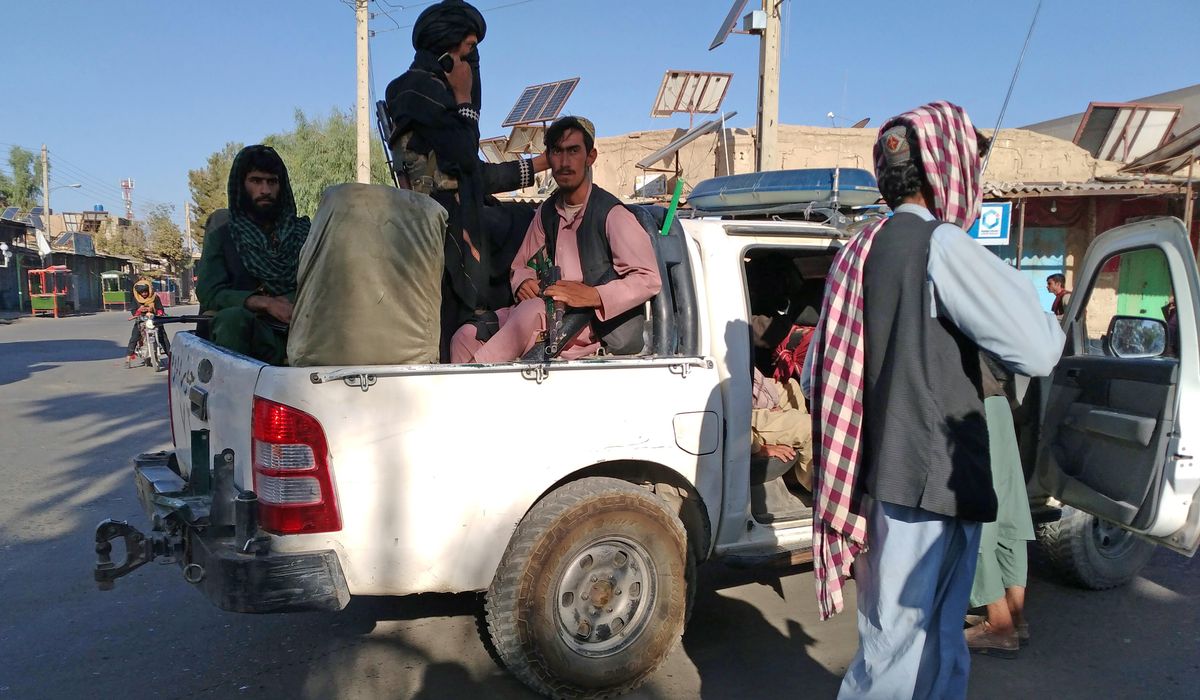
A fast-moving Taliban offensive could leave all of Afghanistan, including the capital of Kabul, in the hands of the radical Islamist insurgency within 90 days, U.S. intelligence assessments reportedly show. Taliban forces now control about two-thirds of the territory in the vast country as the Pentagon completes its troop withdrawal after a two-decade war.
Provincial capitals in Badakhshan, Baghlan and Farah came under insurgent control Wednesday, and the Taliban displayed a video showing they were in control of a major military base in Kunduz.
Although the rapid pace of the Taliban advance has surprised U.S. and Afghan government officials, security analysts say the warnings were there for those who paid attention.
“The U.S. military lived in a state of denial. Their bias was that [Kabul] was turning things around and that they had the jihadis on the ropes. That was not true,” said Thomas Joscelyn, a senior fellow at the Foundation for Defense of Democracies and senior editor of the organization’s “Long War Journal.”
The pace at which the Taliban continue sweeping up provincial capitals raises questions about how long the government in Kabul can maintain control of the countryside. A U.S. defense official told Reuters that the three-month reassessment of how long Afghan forces can hold on is based on how quickly provincial capitals in the south and north of the country have been falling just in the past week.
The Trump and Biden administrations placed a bet that the Taliban, faced with along stalemate in the war, would modify their demands and their harsh Islamic rule as the price to pay to once again share power in the country. But the Taliban leadership has a single objective in mind and securing a seat at a diplomatic table to discuss a negotiated settlement in Afghanistan is not it, Mr. Joscelyn said.
“They want to bring the Islamic Emirate back to Afghanistan and then expand it — that’s their goal,” he said. “I don’t think America has understood who they were fighting the whole time.”
President Biden this week defended his decision to pull out the last U.S. troops from what has been the country’s longest war. He said Afghans now must “fight for their country” if they want to halt the Taliban advance. But Afghanistan‘s army has proved unexpectedly vulnerable with the removal of U.S. and allied troop support, even as the Taliban forces appear emboldened by the turn of events.
“There’s plenty to criticize about the lack of Afghan leadership, [but] the Americans didn’t make the situation better. They made it worse,” Mr. Joscelyn said.
The news on the ground has been stunningly bad for the Afghan government even before American and NATO troops complete their withdrawal by the end of the month. In Farah, one of the cities now under Taliban control, the fighters were seen dragging the bloody corpse of an Afghan security forces member while shouting, “God is great!” They also have commandeered pickup trucks and Humvees and were seen carrying weapons that had been given to the Afghans by the U.S., according to The Associated Press.
“The situation is under control in the city. Our mujahedeen are patrolling the city,” one Taliban fighter told the wire news service.
Department of Defense officials insist they have not abandoned their Afghan allies to their fate. They say they are “mindful of the deteriorating security situation” but insist it’s not too late for government forces to achieve success on the battlefield.
“It really depends on the kind of political and military leadership that the Afghans can muster,” chief Pentagon spokesman John Kirby told reporters Wednesday. “They have the capability, and they have the capacity. Now it’s really the time for them to use those things.”
Pentagon officials wouldn’t comment on the situation. They said the strategy was developed and conducted by the Afghan forces with only modest support — chiefly air power — from the U.S.
“Our focus is getting the drawdown done in a safe and orderly way,” Mr. Kirby said. “Those aren’t battles we are involved in on the ground.”
He had no comment about reports that the deteriorating situation could force an evacuation of the U.S. Embassy in Kabul.
U.S. combat aircraft have flown multiple airstrikes in the last few days to support the Afghan forces, and American officials say they remain committed to helping the country’s air force take on the Taliban. Last month, the Pentagon turned over three Black Hawk helicopters with another 34 to follow. The U.S. also purchased three A-29 propeller-driven strike aircraft for the Afghan military and is helping to refurbish their fleet of Soviet-era Mi-17 helicopters.
“They have advantages, and now is the opportunity to use them,” Mr. Kirby said. “It’s really about having the will and the leadership to use those advantages to their own benefit.”
But in a sign that the U.S.-backed government is deeply concerned about battlefield reverses, Afghan President Ashraf Ghani replaced the army chief of staff as the Taliban seized three more provincial capitals in their blitz across the country’s northeast.
“That is not a good sign. It’s always a leading indicator of collapse,” Mr. Joscelyn said. “They need to find somebody who is capable of stopping the bleeding and turning back the tide.”
Even after Mr. Biden announced a complete U.S. military withdrawal of combat troops from Afghanistan, U.S. officials said they will maintain a relationship with the Afghan government, although it will be largely financial and logistical.
“It would be wrong for us not to acknowledge that we did help enable some progress in Afghanistan,” said Mr. Kirby, citing more educational opportunities for women and children, economic advances and a fledgling yet still viable democratic government.
The Taliban were fighting for a military victory even as U.S. officials pressured their Afghan allies to accept a draw on the battlefield that could lead to a negotiated settlement.
“They already gamed it out. They had better military strategists than the Americans had,” Mr. Joscelyn said. “America never understood its enemy.”







